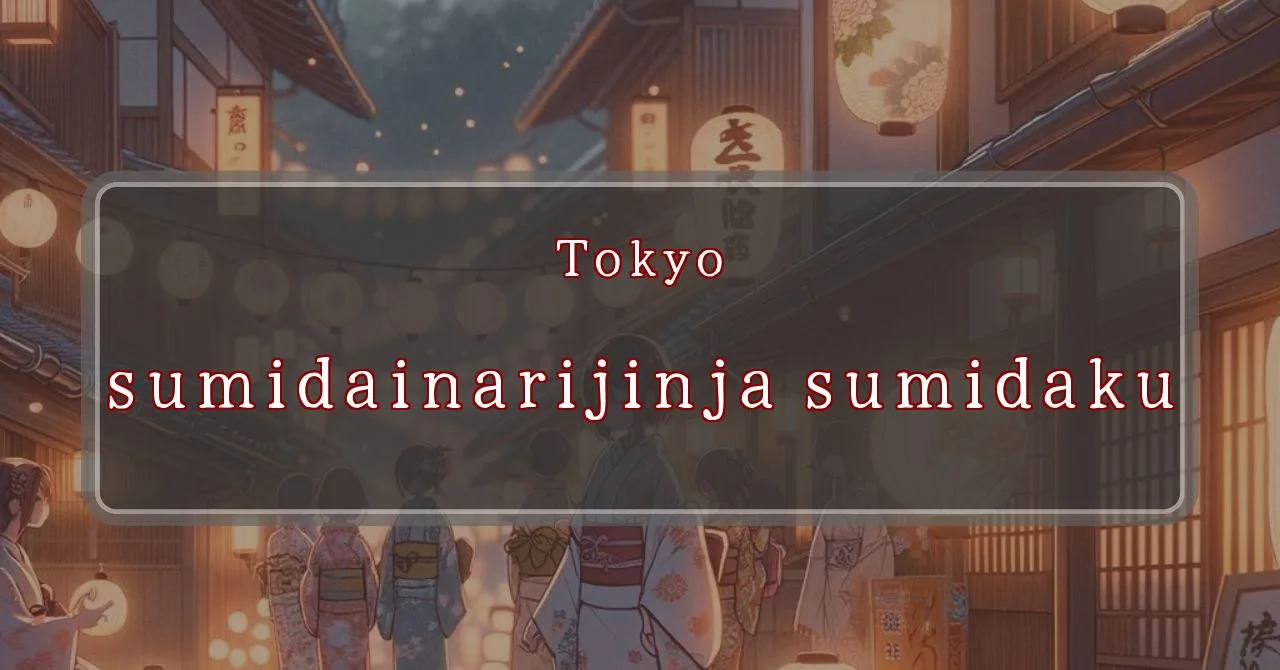Gleaming lanterns illuminate the summer night
Basic Information
Sumida Inari Shrine is a Shinto shrine located in Sumida Ward, Tokyo, Japan. It is dedicated to Inari, the god of rice and sake.
- Address: 4-38-13 Sumida, Sumida-ku, Tokyo 131-0031
- Phone Number: 03-3611-7846
- Access: 7-minute walk from Tobu Isezaki Line Kanegafuchi Station or Keisei Oshiage Line Yashiro Station
- Festival Days: June 15th, 2024 (Reiwa 6)
Main Events and Attractions of the Festival
The Sumida Inari Shrine Festival is a lively and colorful event that attracts many visitors each year. The main events and attractions of the festival include:
Mikoshi Procession
A highlight of the festival is the mikoshi procession, where a portable shrine is carried through the streets of Sumida Ward. The mikoshi is decorated with colorful tapestries and lanterns, and it is accompanied by music and dancing.
Kagura Performance
Kagura is a traditional Japanese dance and music performance that is often performed at Shinto shrines. During the Sumida Inari Shrine Festival, kagura performances are held in the shrine’s main hall.
Food Stalls
A variety of food stalls are set up at the festival, offering a wide range of Japanese and international cuisine. Visitors can enjoy everything from traditional Japanese dishes like yakitori and takoyaki to more modern fare like pizza and hamburgers.
Games and Activities
There are also a number of games and activities for children and adults to enjoy at the festival. These include traditional Japanese games like ring toss and goldfish scooping, as well as more modern games like face painting and balloon animals.
Fireworks Display
The festival concludes with a spectacular fireworks display over the Sumida River. The fireworks are launched from a barge in the river, and they light up the night sky with their brilliant colors.
Blessings and Deities
Sumida Inari Shrine is dedicated to Inari, the god of rice and sake. Inari is one of the most popular deities in Japan, and is revered for its association with good fortune, prosperity, and success. Inari is often depicted as a white fox, and foxes are considered to be Inari’s messengers.
- Deity: Inari, the god of rice and sake
- Blessings: Good fortune, prosperity, success
- Symbol: White fox
Origin and History
The origins of Sumida Inari Shrine are unclear, but it is believed to have been founded in the 16th century. The shrine was originally located in a different part of Sumida Ward, but it was moved to its current location in 1872. The shrine was destroyed by fire in 1945, but it was rebuilt in 1950.
- Founded: 16th century
- Moved to current location: 1872
- Destroyed by fire: 1945
- Rebuilt: 1950
Tips and Notes for Visitors
Here are some tips and notes for visitors to Sumida Inari Shrine:
- Hours: The shrine is open from 9:00 AM to 5:00 PM.
- Admission: Admission to the shrine is free.
- Dress code: There is no specific dress code for visiting the shrine, but it is considered respectful to dress modestly.
- Photography: Photography is permitted at the shrine, but it is important to be respectful of other visitors.
- Smoking: Smoking is not permitted in the shrine.
Parking Information
There is no parking lot at Sumida Inari Shrine, but there are several public parking lots nearby. The closest parking lot is located at the Sumida Ward Office, which is a 5-minute walk from the shrine.
- Sumida Ward Office Parking Lot
- Address: 1-1-2 Oshiage, Sumida-ku, Tokyo
- Hours: 8:30 AM to 5:30 PM
- Rates: 100 yen per 30 minutes
Popular Stalls and Food Carts in Recent Years
| Type of Stall | Description |
|---|---|
| Takoyaki | A staple at Japanese festivals. Characterized by a crispy outside and a creamy inside. |
| Jaga Butter | A simple yet popular snack of hot potatoes lavishly topped with melted butter. |
| Baby Castella | Small castella cakes, sweet and fluffy treats enjoyed by children and adults alike. |
| Grilled Ayu with Salt | Fresh ayu fish grilled whole with salt, a savory taste of Japanese summer. |
| Shaapin | A unique gourmet item influenced by foreign cuisine, with a chewy skin wrapping the filling. |
| Okonomiyaki | A Japanese grilled dish where you often choose your own ingredients for a personalized flavor. |
| Cotton Candy | A fluffy, sweet snack that’s extremely popular with children. |
| Chocolate Banana | A banana coated in chocolate, a fun and visually appealing dessert. |
| Kushiyaki | Various types of ingredients skewered and grilled, an easy-to-enjoy snack. |
| Yakisoba | Fried noodles mixed with a special sauce, a fast food favorite in Japan. |



